剑桥国际英语教程Unit16共63页
- 格式:ppt
- 大小:3.53 MB
- 文档页数:63
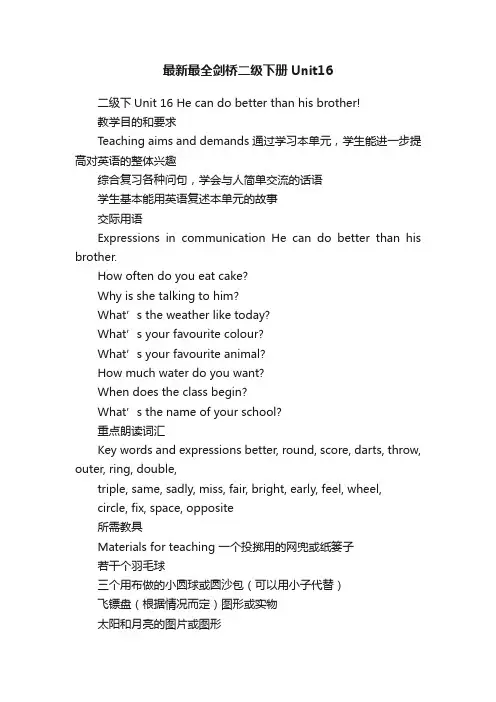
最新最全剑桥二级下册Unit16二级下Unit 16 He can do better than his brother!教学目的和要求Teaching aims and demands 通过学习本单元,学生能进一步提高对英语的整体兴趣综合复习各种问句,学会与人简单交流的话语学生基本能用英语复述本单元的故事交际用语Expressions in communication He can do better than his brother.How often do you eat cake?Why is she talking to him?What’s the weather like today?What’s your favourite colour?What’s your favourite animal?How much water do you want?When does the class begin?What’s the name of your school?重点朗读词汇Key words and expressions better, round, score, darts, throw, outer, ring, double,triple, same, sadly, miss, fair, bright, early, feel, wheel,circle, fix, space, opposite所需教具Materials for teaching 一个投掷用的网兜或纸篓子若干个羽毛球三个用布做的小圆球或圆沙包(可以用小子代替)飞镖盘(根据情况而定)图形或实物太阳和月亮的图片或图形本单元第三部分所需要的用具和材料如何导入教学?上课时,教师对学生说:“Today we are going to play lots of games. Do you like to play games? First want to divide our class into two teams. Boys stand on this side, in a line, Girls stand on this side, in a line. We are going to throw the shuttlecock into the net/basket. Then we’ll see which team has more shots. Do you understand? Let’s get ready.” 教师在地上画一条线,距离大约在两米以外。

What's your excuse?JuneSome good excuses•"Morning. I'm not going to be in today. I was up all last night sick. My stomach feels terrible."•"I won't be in today, I am not feeling well." •"I've spent the last 12 hours either in bed or in the bathroom. I don't think I should go to work today."•"I feel terrible, and I just don't think it would be fair to you or my co-workers to come to work in this condition -I'd be pretty useless."I never seem to have enough time•"My schedule this week is a little tight."•"I’m all booked up. I’m booked solid."•"I’m otherwise engaged."•"I’ve already made other arrangements."•"I just can’t make it."•"I don’t seem to have the time."Different kinds ofexcuses----When you want be lazyFIRST------Disease•1 Have a fever•2 Have a toothache and want to see a doctorFIRST------Disease•3 Have a stomachache•4 Have abdominal[æbˈdɑmənəl] pain (girls may use it usually)•……SECOND------Accident•3A roommate was ill and must sent him or her to hospital•4 Money was stolen•……THIRD------Other•1 I’m not in the mood•2 My bed was broken•3 Student union have activities •……1 Snapshot•Have you ever heard any of these excuses? Have you ever used any of them.•Which are good excuses? Which are bad excuses?•What other excuses can you make for not accepting an invitation?2 Perspectives Who said it?• A Who do you think made these requests? Listen and match each request with a person. • B Pair work Can you think of another request each person might make?4 Speaking What a request!• A Think of requests that people have made recently. Write two things people asked you to do and two things people asked you not to do .• B Group work Compare with others. Who has the most interesting or unusual requests? Who did what was asked?•Example:•A: My mom asked me to get a haircut.•B: What did you tell her?5 Word Power• A Find three words or phrases in the list that are usually paired with each verb. Then compare with a partner.• B Pair work•Example:• A I never tell a lie.• B Are you sure? What if someone asks how much you weigh?6 ConversationAre you doing anything on Saturday?•Book closed:•Daniel is going to Albert's surprise birthday party. Amanda told him not to say anything to Albert. Now Albert is calling to invite Daniel to dinnerthat night! If you were Dainel, would you tell the truth or a lie?Questions: ( Listen to the CD )•1.Does Daniel make an excuse ? an apolopy ?• 2. How does Albert respond? Does he express anger? regret?• 3. What should Daniel have done ? What would you have done in Albert's situation?Vocabulary•How are things: How are you?•Oh, that's too bad ! : I'm sorry to hear that sth. disappointing/ bad has happened.•make it: be able to go to an eventB Pair Work•Make up you own excuse for not accepting an invitation.Making appointments•How about the…•Is the _________ convenient for you…•What about next….•I’m sorry I can’t but _______ is free, is that good for you?•Is _________ good for you?Politely Apologizing•I’m extremely sorry…•I hate to do this but…•I can’t be sorry enough but…•My deepest apologizes…•Unfortunately…•If there were any way I could, I would b ut…7 Listening He said, she said Tips:•be around: at here•see you around: see you then •I'm wondering•run-down: weak• a dance club•set up•look forward to•terrific surprise7 Listening He said, she said• A• d e b a•B•Albert came here singing " happy birthday " to himself. When he opened the door, all his friends shouted, " Surprise! Surprise ! Happy birthday!" Albert was really surprised and said," I can't believe it!" He immediately asked Amanda if she set it up.10 Speanking Good intentions• A Group work What are some things you would like to do in the near future? Think of three intentions.•A: I'm going to learn how to sail.•B: That sounds fun. Are you going to take lessons?10 Speanking Good intentions• B Class activity•Report the best intentions you heard. Then predict which ones will happen.•"Tatyana said she was going to learn how to sail, but she doesn't want to take lessons."11 Writing A voice mail message •Listen to messages•Tips:•Seafood GrillReading P111When is it ok to tell a little white lie?•When is it ok to lie? Is it ok to lie to avoid taking the blame? Avoid hurting someone’s feelings?•Are you ok with little white lies?•How often do people lie?•Who lies more, men or women?Men are bigger liars than women, says survey•In a poll of 3,000 people, researchers found that the average British man tells three lies every day, that's equivalent to 1,092 a year.•However the average woman appears more honest, lying 728 times a year -around twice a day.•Moms are the people mostly likely to be lied toTop Lies•Men1. I didn't have that much to drink2. I had no signal3. I’m stuck in traffic4. No, that doesn’t make you look fat •Women1. Nothing's wrong, I'm fine2. It wasn't that expensive3. It was in the sale4. I’ve got a headache13 Reading P111•big lies•protect a fiendship•the average people•hide something•date sb.•make an excuse•stretch the truth13 Reading P111• C Group work•Can you think of other reasons people tell white lies? What white lies have you told recently?。
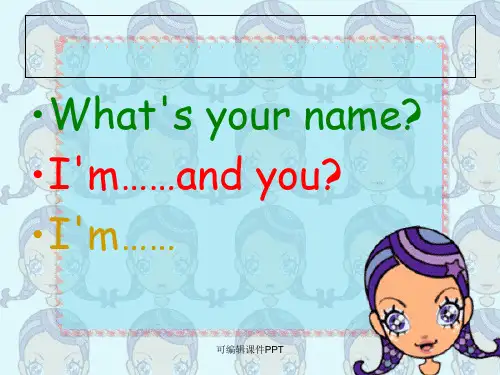
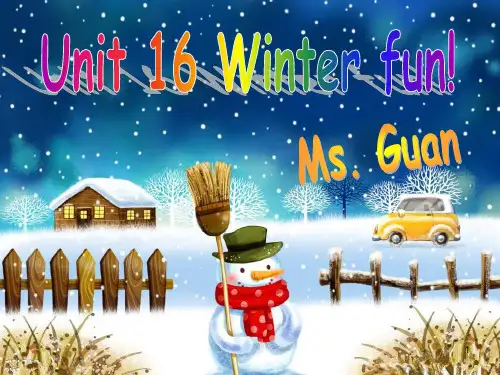
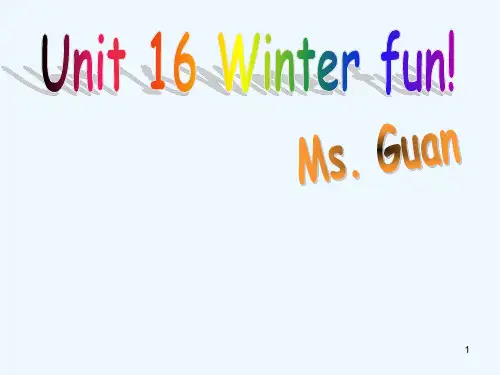
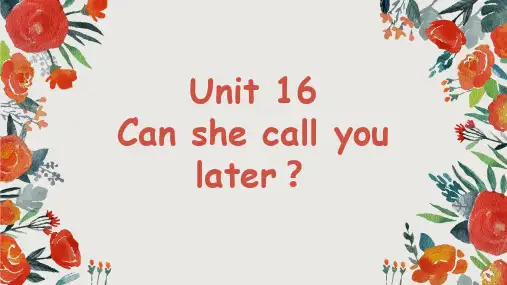
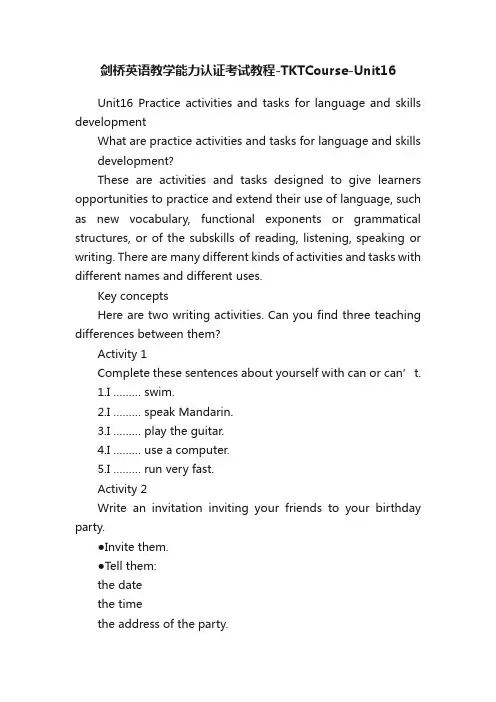
剑桥英语教学能力认证考试教程-TKTCourse-Unit16Unit16 Practice activities and tasks for language and skills developmentWhat are practice activities and tasks for language and skills development?These are activities and tasks designed to give learners opportunities to practice and extend their use of language, such as new vocabulary, functional exponents or grammatical structures, or of the subskills of reading, listening, speaking or writing. There are many different kinds of activities and tasks with different names and different uses.Key conceptsHere are two writing activities. Can you find three teaching differences between them?Activity 1Complete these sentences about yourself with can or can’t.1.I ……… swim.2.I ……… speak Mandarin.3.I ……… play the guitar.4.I ……… use a computer.5.I ……… run very fast.Activity 2Write an invitation inviting your friends to your birthday party.●Invite them.●Tell them:the datethe timethe address of the party.We can see that both these activities give learners an opportunity to use language, but in different ways.Activity 1Activity 2●is a controlled/restricted practice activity because learners can only usecertain items of language●focuses on accur ate use of language●is a gap-fill exercise.●is a less controlled/freer practice activity because the language the learnerswill use is not carefully limited or controlled●focuses on communicating a message●is a task.The same kinds of differences can also be seen in other activities for speaking, writing and learning new language. Drills (guided repetitions), copying words or sentences, jazz chants, dictation and reading aloud are other examples of controlled practice activities. In freer activities the teacher or the materials do not limit the language that learners use. Examples of these are: discussions; solving problems through exchanging ideas; sharing or comparing ideas, information or experiences; writing emails, stories, letters, invitations or compositions.Here are six more activities. What skill/subskill/language do they focus on? What is the name of the type of activity?1.Read the story. Then answer these question:a How old is girl?b Where does she live?c What is her friend’s name?2. A Listen to the tape and choose the best answer:The children’s school is:a near their houseb near the shopsc opposite the post officeB Now listen again. Are these sentences true or false?a The school is new.b The classroom is big.c The library has may books.3. Look at these pictures and then read the story. Put the pictures in the correctorder. Write the correct number (1-6) under each picture.4. Listen to the tape, and in pairs fill in this form:Girl’s name: ………………….Girl’s address: ………………..Name o f girl’s friend: ………..5.Work in pairs. Each of you should use one of these role cards.A Your friend has a problem. Give him/her the best advice you can.B You have a problem. You want to go to university, but you findstudying very difficult. Ask your friend for advice.6. Get into groups of four. Find out which food your friends like and dislikemost. Ask:Which food do you like most?Which food do you dislike most?Here are the answers to the question above:We can see that activities can differ in several ways: the skill or subskill they focus on; what type they are and what interaction patterns they use. The kinds of skills or language they focus on and the interaction patterns they use are not fixed. So, for example, multiple-choice questions could be used for reading, listening or grammar activities and can be done individually, in pairs or in groups.Similarly, form-filling could be used for reading, listening or grammar practice, and done individually, in pairs or in groups.Activities 5 and 6 both involve learners talking to one another to exchange information they don’t know. This means they are talking order to communicate, not just to practice language. This kind of activity in which learners exchange information that only one of them has is called an information gap or a communicative activity.An activity may focus on accuracy or communication depending on how it is introduced by the teacher or the materials. For example, the survey above is focused on accuracy because it limits the language that learners use to ask and answer two specific questions. If the instructions for the activity were ‘Findout about your friends’likes and dislikes in food’, this would not restrict learners’choice of language and the activity would focus on communication.Key concepts and the language teaching classroom●When selecting activities for practising language or the skills of speaking orwriting, we need to decide whether to do a controlled practice or a freer practice activity, an activity that focuses on accuracy or on communication.●When choosing activities for developing skills, we need to decide which skillor subskill to focus on.●Lessons usually consist of a series of linked activities. There are severaldifferent ways of linking activities in lessons. These are just some of them:1.PPP:Presentation →controlled practice activities →freer practiceactivities2.TBL: Discussion →tasks →presentation →focus on form3.Skills-based lessons: Warmer and lead-in →comprehension tasks →post-task activitiesExample I: A listening skills lessonLead-in: discussing the topic of the listening and learning any important new vocabulary →Comprehension tasks: listening to the recorded conversation again and completing a form with specific information →Post-task activities: brief discussion of the topic of the conversation.You can see that the comprehension activities (for listeningor reading) start with focusing on more general levels of comprehension before moving on to subskills that require paying more detailed or specific attention to the text.Example 2: A topic-based lesson which develops several skills Lead-in: speaking about the topic and doing related language work →T asks: listening to a recording about the topic →reading a text about the topic →Post-task activities: discussing the topic and/or focus on the language of the topic →writing a composition about the topic.See Unit 18 and 20 for planning activities for lessons and Unit 26 for language useful to the teacher for carrying out activities.FOLLOW-UP ACTIVITIES (See page 173 for answers)A.choral drilling of pronunciationB.role-playC.dictationD.discussionsE.gap-fill exercisesF.story writingG.copying wordsH.repeating new wordsI.describing picturesJ.learning conversations by heartK.problem solving2.Which skill(s) could these activities be used to develop?A.story completionB.form-fillingrmation gapD.true/false questionsE.role-playREFLECTIONThink about these learners’ comments:1.I don’t like doing lots of different activities –it’s confusing.2.I like doing a mixture of activities with some focusing on accuracy and someon fluency. That really helps me learn.DISCOVERY ACTIVITIES1.Look through two pages of your coursebook. Can you name all the differentkinds of activities it contains? What is the purpose of each activity?2.Look at to see lots of different activities fordeveloping skills and language.3.Look back over this unit and find a type of activity that you have never taughtbefore. Try it with one of your classes. Did it work well? Was it successful?Write up your thoughts in your TKT portfolio.e the TKT Glossary to find the meaning of these terms: chant, jumbledpictures, labeling, prioritizing, project work.TKT practice task (See page 176 for answers)For question 1-7, match the descriptions with the teaching activities listed A-H. There is one extra option which you do not need to use.Descriptions1.The teacher says a word and asks all the learners to repeat it together.2.The teacher puts learners in pairs and asks one of them to act as a lost touristasking the way, and the other as a local person giving directions.3.The learners use maps to work out the best way to get from X to Y.4.The learners listen to a tape and complete a timetable.5.The learners ask all their classmates their opinion about something and thennote it down.6.The learners go to the local museum, the library and the internet to find outabout dinosaurs. They then make an exhibition of wall posters about them. 7.The learners choose names of objects from a list and write the names underpictures of the objects.。
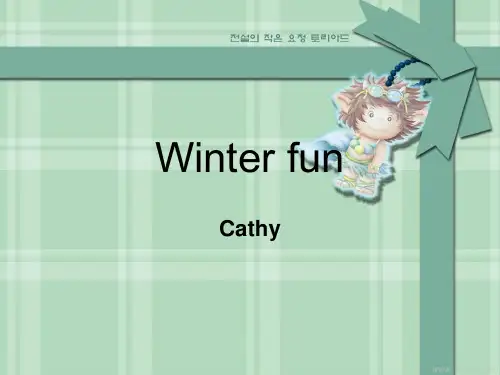
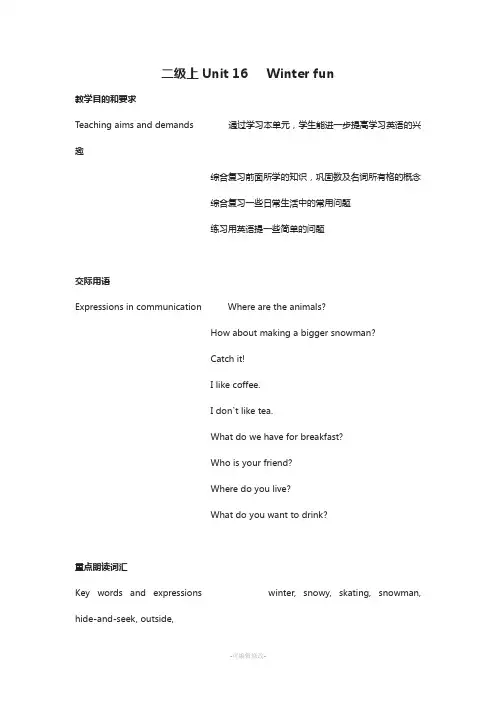
二级上Unit 16 Winter fun教学目的和要求Teaching aims and demands 通过学习本单元,学生能进一步提高学习英语的兴趣综合复习前面所学的知识,巩固数及名词所有格的概念综合复习一些日常生活中的常用问题练习用英语提一些简单的问题交际用语Expressions in communication Where are the animals?How about making a bigger snowman?Catch it!I like coffee.I don’t like tea.What do we have for breakfast?Who is your friend?Where do you live?What do you want to drink?重点朗读词汇Key words and expressions winter, snowy, skating, snowman, hide-and-seek, outside,Paul, Daisy, Mary, John, Bill, Fred, Peter, Jim, Ben, fallingsky, knee, snowflake, hooray, holiday, cinema, kangaroo,guitar所需教具Materials for teaching 教师用白纸剪一些雪花用两张大白纸各画一个雪人准备一些与冬天有关的单词图片及单词卡片准备若干张A4 白纸让学生画画一根长皮筋准备一些白纸和几把剪子如何导入教学?上课时,教师首先问大家:“What season is it now? (winter) Do you like this season? Why and shy not? How many season are there in a year? What are they? What’s your favourite season?”a)问完这些问题后,教师接着说:“Now I want you to tell me how many of you likewinter and how many of you don’t like winter. If you like winter, please stand up.Let’s see how many of us like winter.”教师带着学生数数,最后说出喜欢冬天的人数。
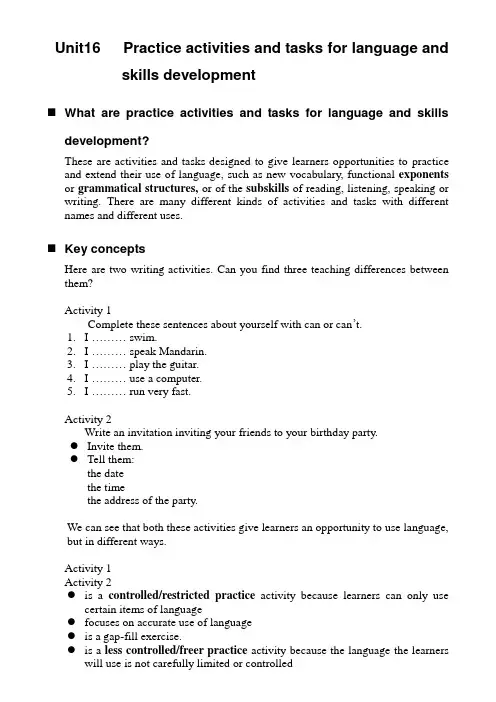
Unit16 Practice activities and tasks for language and skills development⏹What are practice activities and tasks for language and skillsdevelopment?These are activities and tasks designed to give learners opportunities to practice and extend their use of language, such as new vocabulary, functional exponents or grammatical structures, or of the subskills of reading, listening, speaking or writing. There are many different kinds of activities and tasks with different names and different uses.⏹Key conceptsHere are two writing activities. Can you find three teaching differences between them?Activity 1Complete these sentences about yourself with can or can’t.1.I ……… swim.2.I ……… speak Mandarin.3.I ……… play the guitar.4.I ……… use a computer.5.I ……… run very fast.Activity 2Write an invitation inviting your friends to your birthday party.●Invite them.●Tell them:the datethe timethe address of the party.We can see that both these activities give learners an opportunity to use language, but in different ways.Activity 1Activity 2●is a controlled/restricted practice activity because learners can only usecertain items of language●focuses on accurate use of language●is a gap-fill exercise.●is a less controlled/freer practice activity because the language the learnerswill use is not carefully limited or controlled●focuses on communicating a message●is a task.The same kinds of differences can also be seen in other activities for speaking, writing and learning new language. Drills (guided repetitions), copying words or sentences, jazz chants, dictation and reading aloud are other examples of controlled practice activities. In freer activities the teacher or the materials do not limit the language that learners use. Examples of these are: discussions; solving problems through exchanging ideas; sharing or comparing ideas, information or experiences; writing emails, stories, letters, invitations or compositions.Here are six more activities. What skill/subskill/language do they focus on? What is the name of the type of activity?1.Read the story. Then answer these question:a How old is girl?b Where does she live?c What is her friend’s name?2. A Listen to the tape and choose the best answer:The children’s school is:a near their houseb near the shopsc opposite the post officeB Now listen again. Are these sentences true or false?a The school is new.b The classroom is big.c The library has may books.3. Look at these pictures and then read the story. Put the pictures in the correctorder. Write the correct number (1-6) under each picture.4. Listen to the tape, and in pairs fill in this form:Girl’s name: ………………….Girl’s address: ………………..Name of girl’s friend: ………..5.Work in pairs. Each of you should use one of these role cards.A Your friend has a problem. Give him/her the best advice you can.B You have a problem. You want to go to university, but you findstudying very difficult. Ask your friend for advice.6. Get into groups of four. Find out which food your friends like and dislikemost. Ask:Which food do you like most?Which food do you dislike most?Here are the answers to the question above:We can see that activities can differ in several ways: the skill or subskill they focus on; what type they are and what interaction patterns they use. The kinds of skills or language they focus on and the interaction patterns they use are not fixed. So, for example, multiple-choice questions could be used for reading, listening or grammar activities and can be done individually, in pairs or in groups.Similarly, form-filling could be used for reading, listening or grammar practice, and done individually, in pairs or in groups.Activities 5 and 6 both involve learners talking to one another to exchange information they don’t know. This means they are talking order to communicate, not just to practice language. This kind of activity in which learners exchange information that only one of them has is called an information gap or a communicative activity.An activity may focus on accuracy or communication depending on how it is introduced by the teacher or the materials. For example, the survey above is focused on accuracy because it limits the language that learners use to ask and answer two specific questions. If the instructions for the activity were ‘Find out about your friends’likes and dislikes in food’, this would not restrict learners’choice of language and the activity would focus on communication.⏹Key concepts and the language teaching classroom●When selecting activities for practising language or the skills of speaking orwriting, we need to decide whether to do a controlled practice or a freer practice activity, an activity that focuses on accuracy or on communication.●When choosing activities for developing skills, we need to decide which skillor subskill to focus on.●Lessons usually consist of a series of linked activities. There are severaldifferent ways of linking activities in lessons. These are just some of them:1.PPP:Presentation →controlled practice activities →freer practiceactivities2.TBL: Discussion →tasks →presentation →focus on form3.Skills-based lessons: Warmer and lead-in →comprehension tasks →post-task activitiesExample I: A listening skills lessonLead-in: discussing the topic of the listening and learning any important new vocabulary →Comprehension tasks: listening to the recorded conversation again and completing a form with specific information →Post-task activities: brief discussion of the topic of the conversation.You can see that the comprehension activities (for listening or reading) start with focusing on more general levels of comprehension before moving on to subskills that require paying more detailed or specific attention to the text.Example 2: A topic-based lesson which develops several skillsLead-in: speaking about the topic and doing related language work →Tasks: listening to a recording about the topic →reading a text about the topic →Post-task activities: discussing the topic and/or focus on the language of the topic →writing a composition about the topic.See Unit 18 and 20 for planning activities for lessons and Unit 26 for language useful to the teacher for carrying out activities.FOLLOW-UP ACTIVITIES (See page 173 for answers)A.choral drilling of pronunciationB.role-playC.dictationD.discussionsE.gap-fill exercisesF.story writingG.copying wordsH.repeating new wordsI.describing picturesJ.learning conversations by heartK.problem solving2.Which skill(s) could these activities be used to develop?A.story completionB.form-fillingrmation gapD.true/false questionsE.role-playREFLECTIONThink about these learners’ comments:1.I don’t like doing lots of different activities – it’s confusing.2.I like doing a mixture of activities with some focusing on accuracy and someon fluency. That really helps me learn.DISCOVERY ACTIVITIES1.Look through two pages of your coursebook. Can you name all the differentkinds of activities it contains? What is the purpose of each activity?2.Look at to see lots of different activities fordeveloping skills and language.3.Look back over this unit and find a type of activity that you have never taughtbefore. Try it with one of your classes. Did it work well? Was it successful?Write up your thoughts in your TKT portfolio.e the TKT Glossary to find the meaning of these terms: chant, jumbledpictures, labeling, prioritizing, project work.TKT practice task (See page 176 for answers)For question 1-7, match the descriptions with the teaching activities listed A-H. There is one extra option which you do not need to use.Descriptions1.The teacher says a word and asks all the learners to repeat it together.2.The teacher puts learners in pairs and asks one of them to act as a lost touristasking the way, and the other as a local person giving directions.3.The learners use maps to work out the best way to get from X to Y.4.The learners listen to a tape and complete a timetable.5.The learners ask all their classmates their opinion about something and thennote it down.6.The learners go to the local museum, the library and the internet to find outabout dinosaurs. They then make an exhibition of wall posters about them. 7.The learners choose names of objects from a list and write the names underpictures of the objects.。

Unit 16 Winter FunTeaching aims and demands:Use the old knowledge to describe four seasons, especially the winter. The main and difficult points:★New words: spring, summer, autumn, winter, warm, sunny, hot, cool, windy, rainy, cloudy, snowy, skating, snowman,hide-and-seek, snowball, snowflake, holiday, kangaroo★Description of the seasons.Teaching materials:课件Teaching process:Activity one: Free talkHow many people are there in your family?Who are they?How many days are there in a week?What are they?What do you do on Mondays?What time do you always eat ice cream?Do you eat ice cream in summer?How often do you eat ice cream in summer?Activity two: New lesson1. New words※Fetch out the words by the free talk above.2. Let them say the words after me, check chorally and individually.3. Say some riddles, let them guess and fill in the blanks.4. Use the sentence pattern below to practice.“How many seasons are there in a year?“What are they?”“What can you see in w inter?”“What do you often do in winter?”……………5. (Part 3) Ask them to listen to the chant and follow it sentence by sentence. After several times, check chorally and individually.6.Play the game, “Merry train”Activity two: Description1. Fetch out by asking a lot of relative questions.2. After their answer, write the key words on the blackboard.3. Connect the key words into sentences.4. Check chorally and individually.5. After that, let them say the description together.6. Give them some time to prepare the descriptions in groups. I’ll check some of them later.Activity three: Part 61. Fetch out by asking some questions.2. Ask them to listen to the tape and follow it.3. Correct some pronunciations.4. Let them say it in a competitive way.Activity four: Summary1.Pass the dice and let some students to say the descriptions of different seasons.2.Recite the chant.Activity five: Homework1.Listen to the tape and follow it.2.Write a passage about one of the seasons.课件使用说明:新知堂课件。